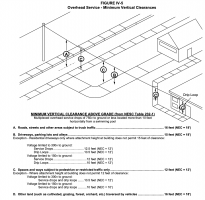Power companies do not follow the NEC. They follow the NESC and that is why you have the different height requirements.
H. Electrical Inspections and Connection of Service When a Customer's electrical installation has been completed, it shall be inspected by the local electrical inspector to ensure compliance with the National Electrical Code and such local rules that may apply. FPL cannot energize new service installations until such inspection has been made, and until formal notice from the inspecting authority has been received by FPL.
Compliance with the National Electrical Code, National Electrical Safety Code and local codes ensures that the installation conforms to recognized minimum safe practices. It is the responsibility of the Customer to comply with all Code requirements
An easy, rule-of-thumb way to think about how the NEC and NESC work together is that the National Electric Safety Code covers the electrical system and utility wiring that supplies power to the “service point” in a building (e.g., usually considered to be the building’s utility meter) and the National Electrical Code covers the electrical wiring that starts at the service point and continues within and throughout the building.
The National Electrical Safety Code is a voluntary standard, but it is frequently adopted as law by state legislatures, municipalities, and public utility commissions.
In those instances where it has been adopted as law, failure of a utility to comply with the National Electrical Safety Code can result in a finding of negligence as a matter of law where the utility’s noncompliance caused an accident resulting in electrocution or serious electric shock injury.
Compliance with the National Electrical Safety Code is generally regulated by a governmental authority such as a state public service commission or public utility commission.

